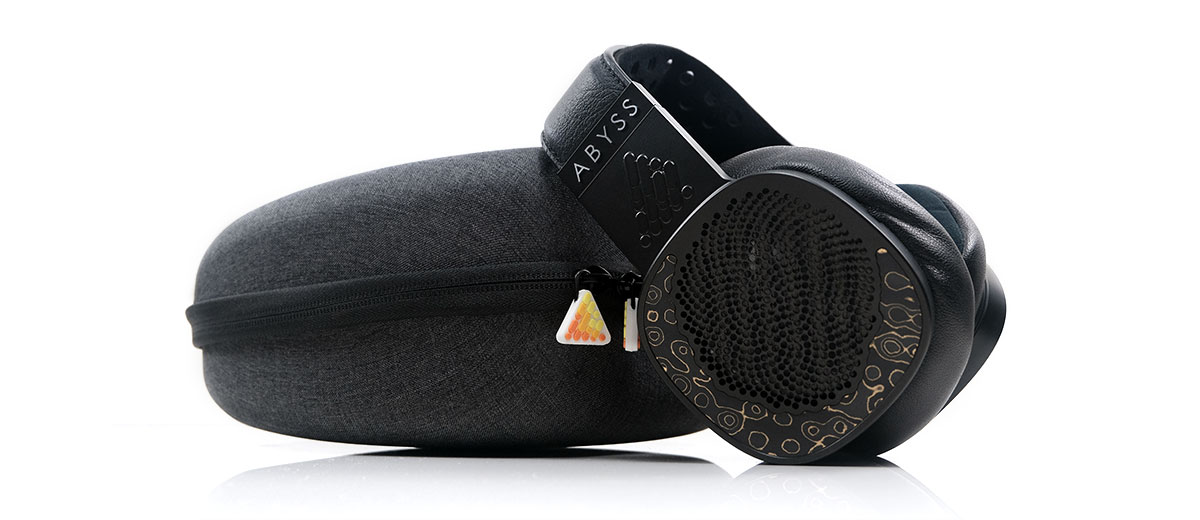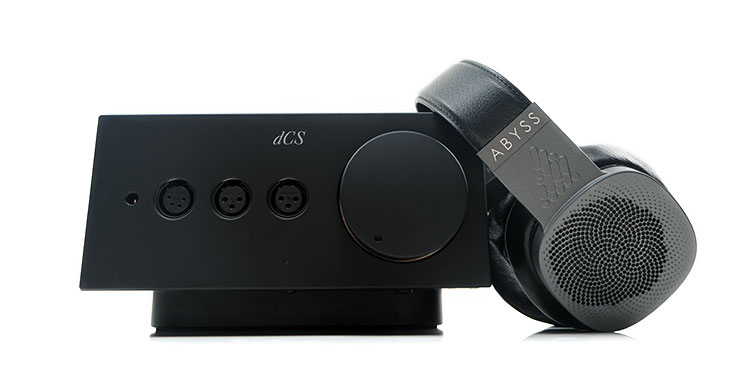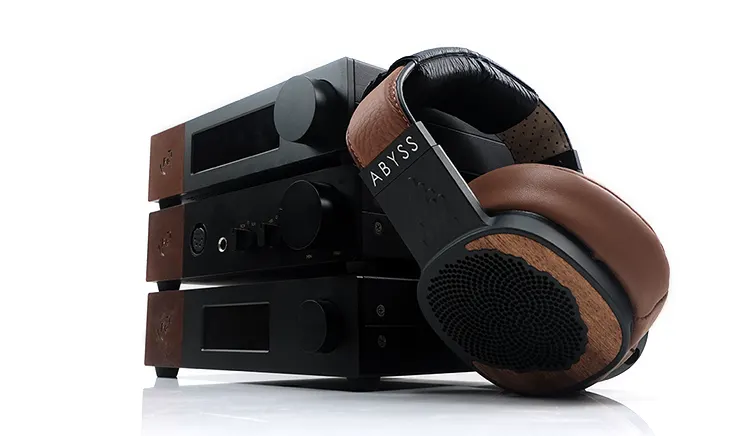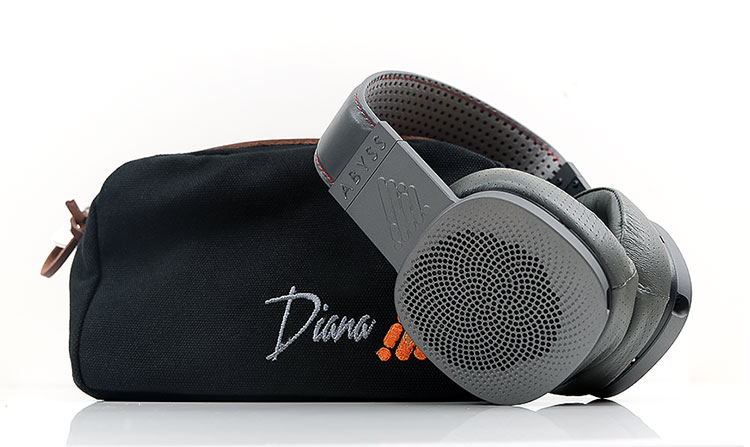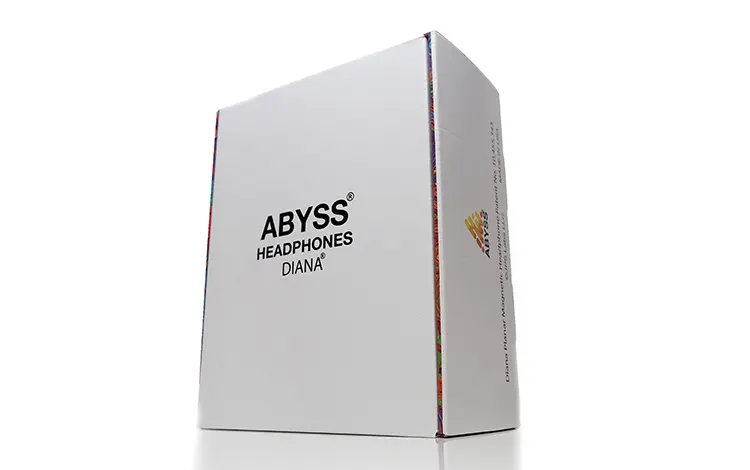Select Comparisons
The following comparisons to the ABYSS Diana DZ were completed using a mix of the Ferrum WANDLA GSE, OOR, and HYPSOS system and dCS Lina Network DAC, Clock, and Headphone amplifier. In both systems, the Diana DZ was used in balanced mode.
ABYSS Diana TC
The ABYSS Diana TC was launched in early 2022, and our review came out in the same year. Until the launch of the DZ, it was the company’s flagship Diana model.
Technical
At least superficially, there isn’t a big difference between these two headphones. Both are open-back acoustical headphone designs with a 63mm planar driver derived from the larger 66mm version inside the AB-1266 TC.
Both drivers use ABYSS’s latest ultra-low mass diaphragm with an improved trace design over the Phi and a larger active surface area on the diaphragm.
They also share the newer Fibonacci patterns on the cup plates introduced on the TC back in 2022. These have wider gaps than the Phi by up to 21.57%, aimed at creating a more open acoustical environment.
That open acoustical environment from the TC is further enhanced with a new flow guide inside the cup of the DZ to improve acoustical transparency and efficiency.
The most obvious technical difference on paper is the enhanced efficiency and sensitivity of the DZ at 50Ω impedance compared to TC’s 69Ω rating and 2 dB more sensitive at 92 dB/mW compared to 90 dB/mW.
Both are still demanding headphones and not as easy to drive as the MR but 2 dB can make a difference at this end of the scale and you should hear that on most good-quality amplifiers.
Design
Although both have matching form factors the Diana DZ M3 frame is drawn from the MR rather than the TC.
Some subtle changes mean ABYSS could shave off about 15-20g of weight depending on which set of earcups you use making it their lightest Diana yet. Nuanced changes such as the flow guide, and the slider wells that have some new production ‘punching’ to reduce metallic mass where possible help reduce the weight even further.
The new pads and pressure strap on the DZ make a substantial difference in the comfort and clamping pressure compared to the TC.
The gripper texture of the pads combined with the softer Ultrasuede contact surface and the wide pressure strap make for an improved pressure balance for longer listening without discomfort.
I must add also the magnetic attachment rings on the bottom of the new Diana DZ hybrid pads have a nicer finish and better magnets but you can also buy these new pads for the TC separately if you want to try them out.
Aesthetically, the DZ follows the design flow originally set by the MR. It’s not as loud or whacky as the last batch of TC color schema currently on offer but the option for the Abalone plates is a bold choice. The sample here is Gold Forged which suits my tastes a bit more.
The DZ did have some color code options, some nice Dark Bronze and Titanium Grey variants (my version) and they are equally as nice to my eye. Rather the Gold Forged just makes the Diana DZ stand out a bit more.
I should mention the TC was the last of the Shoe Box variants with the nice toiletries bag whereas the DZ comes in the new larger box with the dedicated headphone hard case.
Performance
Subjectively the different midrange presentations stand out for me as the key difference between these headphones. The Diana DZ sounds more relaxed over the 1-3k region, not as intimate for vocal delivery as the TC, and also sounds deeper with more perceived space and clarity through the same region.
Objectively I can see how they did that by reducing the 3-4k emphasis and creating a smoother 1-3k range with a reduced 3-5k drop thereafter. The Diana DZ also has a reduced 300-600Hz scoop in the upper bass and lower mids and a more linear mid-bass with better sub-bass presence.
From there, the TC mid-bass bloom around 80-100Hz seems to have been reduced on the DZ, allowing me to appreciate the lower midrange instrumentation imaging more than the TC.
The Diana DZ’s 5-8k region seems to have some added elevation compared to the TC which is more dipped with emphasis on a narrower 8-10k boost, precisely where the DZ starts to attenuate.
That produces a cleaner set of mids and a more harmonically balanced timbre throughout the DZ. With the vocals dropping back just a little the space from you to the stage is enhanced creating a bigger soundstage over the TC.
And it’s not just macro space, but the Diana DZ’s nuanced imaging and layering have improved over the TC. With the TC it is centered a little more with mid-bass and vocal imaging taking center stage, at least comparatively speaking.
The Diana DZ’s more open soundstage allows instruments to breathe better, enhancing the space around and behind them, including the vocal performances. Combined with the improved harmonic balance I would argue the delivery is subjectively the more coherent of the two.
ABYSS Diana MR
The ABYSS Diana MR was launched late in 2023, and our review was published in early 2024. It is arguably the flagship of the company’s easier-to-drive Diana headphone line-up and is cheaper than the DZ.
Technical
The MR, like the Diana DZ, is a compact set of open-back planar driver headphones. As with all Diana headphones, it uses a 63mm driver but with a slightly thicker diaphragm than the ultra-low mass version inside the DZ.
The MR driver’s origins come from the Diana V2 and, in turn, the original Diana model, with successive iterations involving the driver’s trace pattern work to the magnetic field further optimized.
You should not expect the same levels of resolution from this driver but it should sound more euphonic and perhaps more consumer-friendly for want of a better word.
The good news is that the Diana MR is less resistive than the DZ at 30Ω and an SPL almost on par at 91 dB/mw @1kHz compared to 92 dB/mW.
I would still hesitate to say that you can go crazy on a dongle with the MR because a better amplifier will allow it to scale. Rather, you need to start with a better amplifier for the DZ to perform. The MR will do well with something like the Cayin RU7 whereas the DZ will sound less dynamic with the same setup.
Design
All of the production improvements used to reduce weight and mass in the Diana MR frame are taken one step further with the DZ. The result is a 15-20g net weight reduction on the DZ making it even lighter than the MR.
The DZ frame is drawn from the MR so you can pick some nice design choices. My MR sample is finished in a retro wood Sepelle plate accented with some nice, tanned leather and a grey polymer ceramic finish with the same honeycomb finish as the DZ for the headband metal frame.
The comfort levels are also better on the DZ. My MR sample follows the older styling without a pressure strap so there is more of a vertical pressure hotspot. The DZ strap and gripper Ultrasuede contact points with a wider contact surface balance everything nicely.
You can get the new hybrid pads for the MR since all ABYSS pads are compatible with all of their headphones and they will add the new pressure strap so the comfort gap will be erased if you are buying today. No more cheap $10 Sennheiser headband wrap which has done well for me but it’s not even close to the balance of the new strap.
In addition to the headphones, the MR and DZ come with ABYSS’s new packaging style, carry case, and box, though the included cable options are the same.
Performance
Arguably the technical king versus the tonal king. No doubt the Diana DZ is the more technical performer.
Its wider and deeper soundstage is more revealing, the headroom is more noticeable and the space afforded to instruments means nuanced imaging cues are coming through quickly and accurately.
The MR is more intimate and upfront, meaning the whole 1-3k range is more elevated with a stronger vocal presence. You get a richer warmer tonal quality making it the more forgiving of the two headphones.
The bass on the MR is also fuller sounding. It plays out well for me as a daily pick-and-go headphone with casual pop and rock tracks though it’s not quite as revealing or as wide and tall so background instruments play second fiddle to the 1-3k and the bass hump.
The Diana DZ is more linear on the bass right up to 500Hz with a more relaxed 1-3k range and greater elevation and sparkle in the 5-8k range. This is a neutral clean tone, a pure tone if you like, with more emphasis on fast transient responses, articulate imaging, and better depth through the mids in general.
I would take the Diana DZ as my reference headphone and pair it with an amplifier and DAC that can do it some justice be it a dCS Lina stack. If you want something a bit smoother but still crave the big sound then the holographic presentation of the Cayin HA-300MK2 backed by a good DAC is an excellent choice.
The MR can do all of the above relatively well but you can throw in good-quality DAPs, portable amps, and the odd dongle or two since it is much easier to drive than the Diana DZ.
ABYSS Diana Phi
The Top Gear Awards Best Headphones ABYSS Diana Phi is the original high-end Diana release from 2019 and is derived from the AB-1266 Phi technology. It is now discontinued but you can consider it in the same tier as the DZ and the TC.
Technical
The Phi is consistent with the Diana DZ in using a 63mm planar magnetic driver size. It was also the first of the DIANA series to have its driver technology drawn from the flagship AB-1266.
Unlike the Diana DZ, it’s the Phi CC driver rather than the new Phi TC driver. However, both use ultra-low-mass diaphragms and are still considered by ABYSS a step up from the original DIANA driver which is what the MR has evolved from.
Despite its age, the driver has a lower resistance level than the Diana DZ at 30Ω as opposed to 50Ω impedance and just 1 dB less sensitivity at 91dB/mW compared to the DZ’s 92 dB/mW rating.
Both headphones are demanding, and both need a good amplifier with plenty of headroom to shine as they are what I describe as “resolution monsters”.
Design
The Phi was my first Diana headphone series model and I love its design and form factor to this day. The Diana DZ’s similar form factor just continues that fanboyism but takes it to the next level with reduced weight and more design options.
When the Phi first came out you could get it in bronze or grey options with my sample the grey version with carbon fiber headband finishing. It is still a cool aesthetic it’s just not as unique as the DZ Abalone, Gold Forged, or Damascus options.
The reduced weight of 20g feels more substantial in the hand than you might think, at least when holding it side by side with the Phi. The Phi feels heavier, and denser, especially around the slider wells where ABYSS took a lot of mass out of the DZ frame.
Without the headband strap and new flatter contact surface hybrid pads, the Phi is not as comfortable. My Phi is wrapped in the Sennheiser memory foam headband to mitigate the issues but it’s not close to the dissipation of the strap with a narrower focus point.
The older stock pads of the Phi also have a narrower contact point in their fluted design and are not as deep. They tend to do less well with the lateral pressure with those sharper contact points produce physical fatigue quicker than the new DZ pads. If you have a Phi buy the new pads at the very least.
By the way, my Phi is over 5 years old now and looks as fresh as the day it was unboxed. There is no material flaking, no flex noise, and zero electrical problems. That gives me confidence in Diana DZ’s potential life-span.
Performance
Everything about the Diana DZ performance is much more open and refined-sounding than the older Phi model.
I still enjoy the Phi model a lot but you can tell some aspects of its tuning create some harmonic dissonance in areas that the Diana DZ does not suffer from.
For example, upper register falsetto or mixed female vocals have a slight steeliness and emphasized sibilance from a strong but narrow 4-6k peak whereas the DZ sounds smoother and more balanced for those same vocal recordings. The coherence in the Diana DZ midrange timbre is more noticeable.
The second major aspect is how much more open the Diana DZ is than the Phi. The DZ does seem to have a stronger 2-4k dip whereas the DZ still manages to sound quite relaxed with a more consistent elevation up to 3k and a smaller 3-5k drop.
That gives it a more ‘filled-in’ sound to my ear, which, combined with a wider and more atmospheric soundstage, delivers big time on the holographic. The Phi is highly resolving but can sound more centered and slightly softer on the separation with less headroom, particularly with an 8-10k range that sounds more attenuated.
The dynamic range favors the Diana DZ in my setup. I mentioned a slightly softer note definition with reduced separation. I still would define it as detailed but not as dramatic on louder note impacts as the DZ’s performance.
My Verdict
Unless you are a hardcore vocal lover and nothing else the flagship ABYSS Diana DZ is an upgrade on the older TC model. It’s more spacious and holographic sounding with top-notch clarity and a neutral yet refined tonal characteristic.
The build quality is so good that even 5 years later my Phi model looks as good as the day I unboxed it. I expect the DZ to last just as long which is just as well since that enhanced comfort from the new pressure strap and pads likely means it will be on my head a lot more.
The Diana DZ (along with the MR) also puts clear daylight now between the flagship range driver and the MR driver, two Diana headphone models with increasingly distinct tuning profiles and different target audiences.
If you are on the go and want a sound that is forgiving and ‘fun’ get the MR. If the budget allows and you have a great desktop setup and want one of the most insightful presentations currently available, get the DZ.
ABYSS Diana DZ Technical Specifications
- Driver: 63mm planar
- Impedance: 50Ω
- SPL: 92 dB/mw
- Frequency Response: 5 Hz-65 KHz
- Weight: 315g
- Optional accessories include upgraded JPS Labs Superconductor HP cable and vegan earpad options
- 3.5MM, 6.3MM, 4.4MM, and 4-Pin XLR cable options
- CNC-milled Aluminium Frame
- USA Designed and Assembled
- Weight 315 grams; 370-385 grams depending on ear pad configuration.

